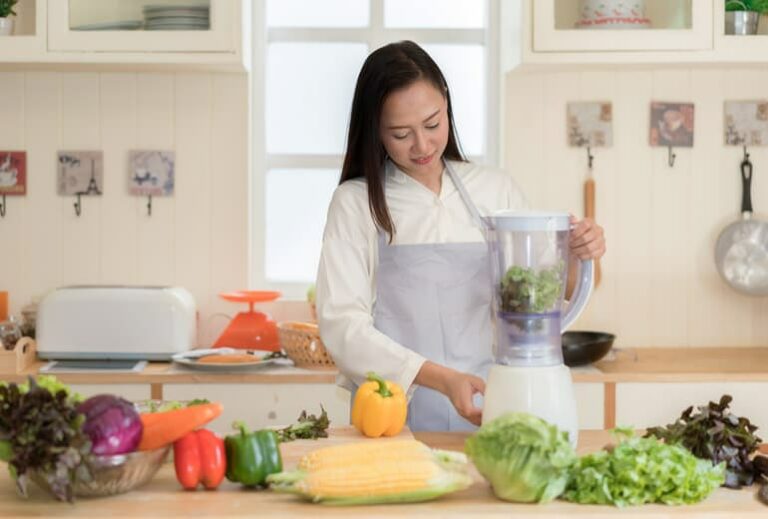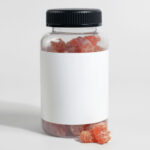Green Smoothies for Diabetes

Recent statistics on type 2 diabetes from the American Diabetes Association are startling1,2:
- One out of every four health care dollars is spent on people with diabetes.
- Diabetes is the most costly chronic illness, at a cost of $327 billion in 2017 alone, up 26% from 2012.
- 1.5 million Americans are newly diagnosed with diabetes every year, with nearly 10% of the population suffering from this condition.
- 25% of adults over the age of 65 have diagnosed or undiagnosed diabetes.
- Diabetes is the seventh leading cause of death in the U.S.
The most disheartening thing of all about diabetes is that most cases type 2 diabetes can be prevented with simple lifestyle changes to whole foods, shifting away from the processed, sugary foods in the Standard American Diet.
Too many people believe these changes are too difficult to make. They may be addicted to the sugars and additives in the foods themselves or dependent on the ease of prepackaged or drive-through convenience. Or they may think a high-protein diet is the answer, which has been proven false. Or they might think all carbs and sugars are the same, which is also not true.
Sugary treats and snacks might seem hard to cut down on, but green smoothies are a solid alternative and can help you make the transition into a healthier lifestyle.
One of the easiest ways to make the transition to whole foods is with green smoothies. They are simple to make, convenient to take on-the-go, and flood the body with disease-preventative fiber and nutrition.
In this article:
- Mistakes People Make With Smoothies for Diabetes
- What Nutrients Will Help Diabetes?
- 5 Smoothie Recipes for Diabetes
In my 450-city lecture tour over six years, one of the most-reported benefits attendees would tell me was that replacing one meal each day with a green smoothie, and making a shift to a whole-foods, mostly plant-based diet reversed or even eliminated their need for diabetes meds, often within one month.
Interestingly, a plant-based diet is fairly high in carbohydrates (sugars and starches), but the fact that the sugars are in their whole-food form, including many nutrients and lots of fiber, makes them unlikely to be any kind of contributing force in the slow progression towards a diabetic condition.
Ready to give green smoothies for diabetes a try? Here’s what you need to know:
Mistakes People Make With Smoothies for Diabetes
When people are new to smoothies, they tend to think about a concoction that consists solely of yogurt and fruit. A green smoothie for improving blood sugar levels or reversing diabetes for someone already diagnosed will look very different! My own green smoothies have minimal fruit low in sugar and no dairy products at all, including yogurt.
Here are some common mistakes people make when turning to smoothies to treat diabetes.
Too Much Fruit
Many people start off their foray into smoothies by going with fruit … and only fruit. While the advantage of smoothies is that you’ll also get the fiber from the whole fruit to slow down the natural sugars’ effect on your blood sugar, you’re better off keeping fruit to a minimum, or even eliminating fruit in your smoothies at first if you’re a full-blown diabetic. Maximize your greens instead.
Fruit is a delicious part of any smoothie, but it’s best used in balance with greens and veggies.
Adding Sweeteners
Without much fruit, you may be wanting a bit of sweetness, but those with diabetes need to be mindful of any sources of sugar, even natural more nutritious versions like organic honey, maple syrup, and raw agave.
Artificial sweeteners are far worse, however, because they are neurotoxins and also alter the gut bacteria, among other unacceptable side effects. Avoid chemical sweeteners like Splenda, Truvia, and Nutrasweet (aspartame) completely! These also tend to confuse the reward and habit centers of the brain leaving you craving more sugar than if you just had something naturally sweet like fruit in the first place3.
I also don’t recommend the sugar alcohols like erythritol, sorbitol, and xylitol. Not only do they have the same brain-confusing effects, too much of them can also cause digestive upset4 (and don’t leave xylitol around — it can be fatal to dogs).
Instead, try a few drops of liquid stevia or monk fruit, which are natural sweeteners that won’t affect your blood sugar. These are still concentrated sweeteners, however, so start with just a drop or two and adjust, you won’t need as much as you think! At some point in your smoothie journey, you won’t need any at all and can enjoy the sweetness of the fruit instead.
One tip I like for sweetness is to add in a high-quality protein powder that is sweetened with stevia or monk fruit; it has the added benefits of slowing down the sugar absorption and of helping you feel fuller longer.
[Related article: The Good, Bad, and Ugly of Sugar Alternatives]
Not Including Fat or Fiber
If you’re making a smoothie for diabetes correctly, the fruits and vegetables you use will have plenty of fiber that will help slow down the release of glucose into the bloodstream. This gives you steadier energy, rather than a big sugar spike that leaves you feeling lethargic, and keeps you fuller longer too.
Fat is another way to help slow down that process, and it’s an important component of making a smoothie into a meal that lasts till your next scheduled meal. You can incorporate good fats in the form of nuts, seeds, nut or seed butters, coconut, and avocado. You can also use their respective oils, though the whole food is always best to get the fiber as well.
Not Checking Blood Sugar
After checking with your health care professional to determine your proper blood sugar levels, it’s important to keep an eye on your levels before and after your smoothie. This monitoring will help you be more aware of how certain ingredients affect your glucose levels, and you can adjust the recipe accordingly.
What Nutrients Will Help Diabetes?
Make sure to include foods with these nutrients in your smoothie:
Chromium
This micromineral is a critical part of glucose tolerance. Without enough chromium, glucose can’t get into your cells to be used or stored properly, and a deficiency can lead to both hypoglycemia and diabetes. Some smoothie-ready ingredients that contain chromium include romaine lettuce, apples, grapes, basil, oranges, and bananas.
Sulfur
Sulfur is an important nutrient for insulin synthesis, or how insulin is generated in the body. A sulfur deficiency can contribute to diabetic symptoms, but proper levels can be restored by supplementing your diet with foods like kale, cabbage, avocado, bok choy, sweet potatoes, peaches, apricots, watermelon, and many nuts. These are all wonderful additions to your next green smoothie.
Vanadium
Vanadium is another micromineral important for combating diabetes, which is why it’s key that we get a variety of mineral-rich fruits, vegetables, legumes, and more whole foods in our diets. Vanadium is a significant factor in blood sugar control, and can be found in oats, parsley, spinach, and more. Fulvic acid is also a great source of microminerals.
Probiotics
Diabetes has been associated with poor gut flora5, so to help balance the good bacteria in the gut, incorporate fermented foods that are rich in probiotics.
Rejuvelac is a great fermented base for a green smoothie, but I usually ferment coconut water because it’s so easy and I can do it overnight to be ready for my morning smoothie. All you have to do is put water kefir grains in coconut water and let it ferment in a jar overnight. I drain the liquid off into my smoothie in the morning, and add more room-temperature coconut water to the jar, for tomorrow.
Other fermented foods that are good in smoothies include unsweetened yogurt, kefir, and homemade kombucha. Dairy products are mucous forming and not helpful for diabetics, so you can make yogurt from coconut, nut, or seed milks as well.
Fermented foods provide beneficial probiotics and are a great addition to any diet.
Be careful blending kombucha––depending on how fizzy yours is, it may bubble up a little too high! Start on a low speed in the blender then increase the speed slowly.
Note: kombucha is my least-favorite fermented food, nutritionally, because of its high sugar content. If you have brewed your own, make sure it’s very tart — that’s the best way to tell if you’ve fermented out most of the sugar. Store-bought brands are usually quite high to be more palatable to the masses.
5 Smoothie Recipes for Diabetes
All of these smoothies contain the right ratio and quality of protein, fat, and fiber needed to maintain stable blood sugar and serve as a proper meal replacement. Individual needs vary, however, so please measure your blood glucose to test whether these recipes work for you, and modify as needed.
The recipes make several servings, so make sure to have mason jars or other containers available to portion out each serving for later (or serve to a crowd!).
Jade Green Smoothie
This beautifully colored smoothie is packed with fiber. Between the apple, celery, ginger, and avocado, your digestion will be running smoothly and your blood sugar will be uber stable. Using a whole avocado provides more than just fiber, it’s got plenty of healthy fat too, and both of those qualities make this a great recipe for a smoothie that serves as a meal replacement.
Ingredients:
- 1 apple
- 1 celery stalk
- 10-12 pieces of parsley
- 1 big handful spinach
- 1 large carrot
- 1 thumb ginger root
- ⅓ cucumber
- 1 avocado
- 1 cup water (or fermented coconut water)
Directions:
Blend all ingredients in a high-speed blender til smooth.
The Umbrella
When in doubt, get the coconut oil out! This smoothie is another fiber-packed blend, and to round out the blood sugar stability ratio, we can add in coconut oil. I like to use this because it’s a fairly neutral addition (as opposed to another healthy fat source like almond butter) that keeps you full and happy without changing the flavor.
Ingredients:
- 1 carrot
- 1 celery stalk
- 1 banana
- 1 roma tomato
- 1 granny smith apple
- 3 handfuls spinach
- 1 cup water
- 1 cup ice cubes
- ½ cup berries (your favorite kind)
- 2 tbsp coconut oil
Directions:
Blend all ingredients in a high-speed blender til smooth.
Green Oats Smoothie
The gang’s all here in this green smoothie! Protein, fat, and fiber work together for satiety and stable glucose, as we’ve mentioned, but this balance also has an added benefit of keeping your moods stable too. Without any sugar spikes or crashes, you don’t experience mood swings or fatigue the way you would with a carb-only mix. Load up your blender and ideally, opt for the sprouted flaxseed versus flaxseed oil. Both are highly nutritious, but the whole seed, especially sprouted, contains more protein and other important nutrients.
Ingredients:
- ½ cup rolled oats, soaked overnight
- ½ avocado
- 1 handful mixed greens
- 1 cup almond milk
- 1 tbsp flaxseed oil or sprouted flaxseed
- 1 tsp vanilla extract
- water, as needed
Directions:
Blend all ingredients in a high speed blender til smooth.
Berries and Cream Smoothie
This is a simple, full-fat blend that will keep you happy until your next meal, filled with low-sugar fruit that pairs nicely with the added vanilla flavor. Experiment with this one. You may not even need the banana thanks to the natural sweet and tart flavors from the berries!
Ingredients:
- 2 big handfuls of spinach
- 1 frozen banana
- ¾ cup frozen berries (blueberries, raspberries, strawberries, or a mix)
- 2 cups water
- ½ cup full-fat coconut milk
- ½ cup raw cashews, soaked
- ⅛ tsp vanilla extract
Directions:
Place all ingredients into a blender and blend until smooth.
Green Monster Smoothie
This smoothie gets you major brownie points in the nutrition department. Pumpkin seeds and flax seeds provide protein and healthy fats, with the flax offering omega-3 essential fatty acids that nourish your brain while keeping blood sugar stable. Feel free to add a dose of cinnamon to the mix too, which is known to regulate blood sugar as well6.
Ingredients:
- 3 large kale leaves
- 1 banana
- 1 apple, peeled and cored
- 1 ¼ cups frozen pineapple
- 1 ½ cups almond milk or other dairy-free milk
- ¼ cup pumpkin seeds
- 1 tbsp flax seed
- 1 inch piece fresh ginger
Directions:
Add all ingredients to a high-powered blender and blend until smooth.
I’m also partial to the green smoothie recipe I almost always use, because it is infinitely versatile and easy to adjust the greens up and fruits down as needed. You can print out this free template that will give you good suggestions for switching out and combining ingredients in my basic green smoothie recipe.
Read next: Need a Healthy Treat? 6 Easy Swaps for Your Favorite Recipes

Disclosure: This post may contain affiliate links that help support the GSG mission without costing you extra. I recommend only companies and products that I use myself.

Sources
- “American Diabetes Association® Releases ‘Economic Costs of Diabetes in the U.S.’ Report at Annual Call to Congress Event Urging Legislators to Make Diabetes a National Priority.” American Diabetes Association. March 22, 2018.
- “Statistics About Diabetes.” American Diabetes Association. March 22, 2018.
- Conti, Lisa. “Artificial Sweeteners Confound the Brain; May Lead to Diet Disaster.” Scientific American. June 1, 2008.
- Mäkinen, Kauko K. “Gastrointestinal Disturbances Associated with the Consumption of Sugar Alcohols with Special Consideration of Xylitol: Scientific Review and Instructions for Dentists and Other Health-Care Professionals.” International journal of dentistry vol. 2016 (2016): 5967907. doi:10.1155/2016/5967907
- Vrieze, Anne, et al. “Transfer of Intestinal Microbiota From Lean Donors Increases Insulin Sensitivity in Individuals With Metabolic Syndrome.” Gastroenterology. Volume 143, Issue 4, October 2012, Pages 913-916.e7
- Hlebowicz, J. et al. “Effect of cinnamon on postprandial blood glucose, gastric emptying, and satiety in healthy subjects.” American Journal of Clinical Nutrition. 2007 Jun;85(6):1552-6. DOI: 10.1093/ajcn/85.6.1552
Posted in: Green Smoothies, Health Concerns, Recipes
















When you mention diabetes in your diabetes information, are you referring to type 1 or type 2?
Excellent question
Hi Drew,
Type 2. In this article, Robyn states: The most disheartening thing of all about diabetes is that most cases type 2 diabetes can be prevented with simple lifestyle changes to whole foods, shifting away from the processed, sugary foods in the Standard American Diet.
Hope you find it helpful!
What do you think about treating obesity with stem cells? I know a wonderful clinic – https://www.startstemcells.com/, they treat a lot of diseases with stem cells, including obesity. Injecting your own stem cells is ideal for treatment of diabetes without any stressful diets. I think this is very interesting.
Great advice and not a surprise at the end of a "short" 45 minute presentation. Thank you!!!!
Hi Robyn, what do you think of allulose? Have u heard of it?